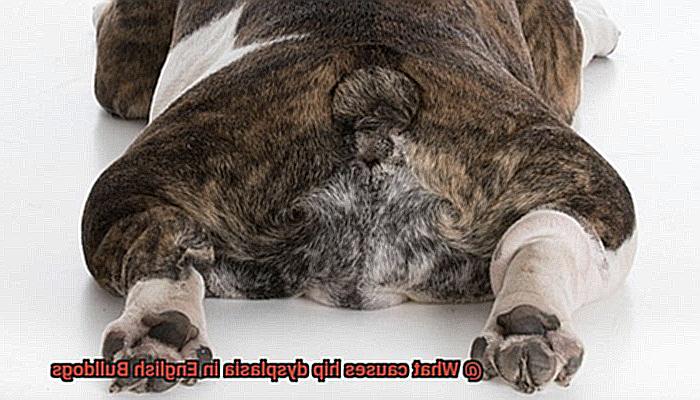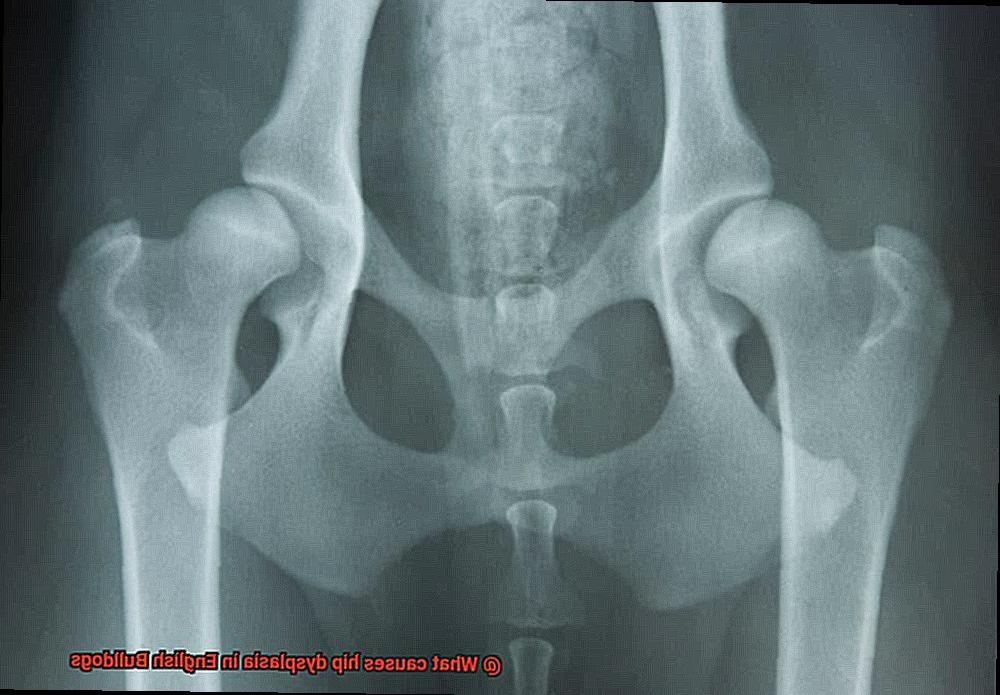What causes hip dysplasia in English Bulldogs?
Hip dysplasia is a serious health issue for English Bulldogs. It can cause pain, arthritis, and even lameness. But what causes hip dysplasia in English Bulldogs?
Genetics plays an important role. If one or both parents had the disease, their puppies are more likely to have it too. So if you’re thinking of getting an English Bulldog, investigate their pedigree first.
Diet also matters. An unhealthy or imbalanced diet can lead to joint pain later in life. Make sure your pup gets all the nutrients they need with a high-quality dog food that’s right for their age and size.

Exercise helps too. Regular exercise maintains muscle mass and keeps joints healthy. Most Bullies only need short walks each day to stay fit and strong.
We can all do our part to prevent hip dysplasia in English Bulldogs by taking steps towards prevention before any signs of pain or discomfort arise due to this painful disease.
Causes of Hip Dysplasia in English Bulldogs
Contents
- 1 Causes of Hip Dysplasia in English Bulldogs
- 2 Symptoms of Hip Dysplasia in English Bulldogs
- 3 Diagnosing Hip Dysplasia in English Bulldogs
- 4 Treatment Options for Hip Dysplasia in English Bulldogs
- 5 Can an English Bulldog Live with Hip Dysplasia?
- 6 Preventing Hip Dysplasia in English Bulldogs
- 7 Genetic Testing for Hip Dysplasia in English Bulldogs
- 8 Diet and Exercise for Dogs with Hip Dysplasia
- 9 Conclusion
English Bulldogs are a beloved breed of dog, but unfortunately they are also prone to hip dysplasia. Many factors can contribute to this disorder, including genetics, nutrition, and environment.
Genetically, English Bulldogs have a shallow hip socket that is not well developed, making it difficult for the hip bones to fit correctly in the socket. This can cause instability and pain in the hips and joints.
Nutrition also plays an important role in preventing hip dysplasia in English Bulldogs. An unbalanced diet or one that is too high in fat or calories can lead to excessive weight gain which puts extra strain on the hips and joints.
In addition, environmental conditions such as lack of exercise or too much exercise can both contribute to hip dysplasia in English Bulldogs. Too much exercise can put extra strain on the joints while lack of exercise can lead to muscle weakness which further weakens the hips and joints.
It’s important for owners of English Bulldogs to be aware of these causes so they can take steps to prevent it from happening in their dogs.
A healthy diet, appropriate exercise levels, and regular vet visits are essential for maintaining your Bulldog’s health and happiness.
Symptoms of Hip Dysplasia in English Bulldogs
English Bulldogs are beloved for their playful and affectionate personalities, but sadly, hip dysplasia can affect this breed as well. Hip dysplasia is a disorder that causes the hip joint to fit improperly, resulting in pain and difficulty moving.
It’s essential to be aware of the symptoms of hip dysplasia in English Bulldogs so that it can be treated immediately. The most common sign is limping, which typically worsens after exercise or strenuous activities. Other indicators include: difficulty getting up from a lying position, reluctance to move, and a reduced range of motion in the hips. Pain may also be present; however, some dogs with hip dysplasia may not show any signs of pain at all.
If left untreated, hip dysplasia can lead to long-term issues such as arthritis and joint degeneration. It’s usually detected when the dog is between 4 and 6 months old, so it’s important to keep an eye out for any signs of limping or reduced mobility in your English Bulldog puppy.
If you suspect your English Bulldog has hip dysplasia, it’s best to bring them for diagnosis and treatment right away.
Diagnosing Hip Dysplasia in English Bulldogs
English Bulldogs are a beloved breed, but they can be prone to hip dysplasia. It’s essential to diagnose this disorder early on so that it can be managed appropriately.
Diagnosing hip dysplasia in English Bulldogs starts with a physical examination from a veterinarian. The vet will assess the dog for pain, joint laxity, and muscle atrophy during the exam. X-rays will then be used to check for any indications of hip dysplasia, such as an increase in the width of the hip joint or a decrease in its congruency.
Other tests may also be conducted for further evaluation. A complete blood count (CBC) is done to look for signs of infection or inflammation, while a urinalysis can rule out urinary tract infections. In some cases, additional imaging studies like an MRI or CT scan may also be performed to confirm the diagnosis.
It’s important to identify and treat hip dysplasia in English Bulldogs as soon as possible so that they can enjoy a healthy life.
Treatment Options for Hip Dysplasia in English Bulldogs
There are several medical treatments available that may be beneficial. Non-surgical treatments such as weight management, exercise, physical therapy, and medications can all help reduce pain and inflammation.
If the condition has become severe or if the dog is unable to bear its own weight, surgery may be recommended. Hip replacement, femoral head ostectomy (FHO), and triple pelvic osteotomy (TPO) are among the surgical options that can improve mobility and reduce pain in affected dogs.
In addition to these treatments, you can also supplement your dog’s diet with glucosamine and chondroitin to reduce inflammation and improve joint health.
Finally, make sure your pup has a soft bedding surface to rest on and avoid activities that could further aggravate their condition.
Can an English Bulldog Live with Hip Dysplasia?
Don’t worry, with the right care and management, they can still lead a happy and healthy life. Hip dysplasia is a medical condition that can cause pain and discomfort, but it doesn’t have to be the end of the road for your pup.
It’s important to know the signs and symptoms of hip dysplasia so that you can diagnose and treat it as soon as possible. Treatment options vary depending on the severity of the condition but may include physical therapy, medications, supplements, or surgery.
Preventing Hip Dysplasia in English Bulldogs
English Bulldogs are beloved pets, but they can be prone to hip dysplasia. However, there are ways to help your Bulldog stay healthy and prevent this condition.
First, ensure your Bulldog has a balanced diet with the right amount of calories and high-quality food. This is essential for its health and long life.
Second, exercise regularly. Exercise keeps joints flexible and muscles strong, which can reduce the chances of hip dysplasia.

Third, maintain a healthy growth rate by feeding it the right amount of food for its breed and age.
Fourth, keep your Bulldog at a healthy weight by avoiding obesity. Excess weight puts extra strain on hips, resulting in hip dysplasia.
In dogs with hip dysplasia, consider joint supplements such as glucosamine and chondroitin sulfate to reduce inflammation and improve joint health.
Finally, neutering or spaying at an early age can also help prevent hip dysplasia in English Bulldogs.
Genetic Testing for Hip Dysplasia in English Bulldogs
You should be aware of the importance of genetic testing for hip dysplasia. This is the most reliable way to diagnose and treat this condition in English Bulldogs.
Various types of tests are available, including DNA testing, X-rays, and MRI scans. These tests can help identify the gene mutation that causes hip dysplasia in English Bulldogs. Once the gene mutation is identified, veterinarians can create a personalized treatment plan tailored to an individual dog’s needs.
Genetic testing is also beneficial for breeders who want to ensure their puppies have healthy hips and don’t carry any genetic predispositions for hip dysplasia. By doing genetic testing, they can be sure they’re raising puppies with strong hips.
If you own an English Bulldog, it’s essential to consider hip dysplasia genetic testing. This will help ensure that your dog receives the best care possible and that any puppies raised by breeders are healthy and robust.
Diet and Exercise for Dogs with Hip Dysplasia
Dealing with hip dysplasia in dogs can be a daunting task, but there are steps you can take to help your pup manage the condition. Diet and exercise are two of the most important aspects to focus on.
Start by feeding your pup a high-protein, low-fat diet. This will help them maintain a healthy weight, which is essential for reducing the symptoms of hip dysplasia. Additionally, adding omega-3 fatty acids from fish oil to their diet can help reduce inflammation and pain in affected joints.
Exercise is also key when it comes to managing hip dysplasia in dogs. Moderate exercise such as walking and swimming can strengthen the muscles around the hips and improve joint flexibility. Just be sure not to overdo it as this could lead to further joint damage.
Also Read: What causes a dry nose in English Bulldogs?
Conclusion
Dealing with hip dysplasia in English Bulldogs can be daunting, but it doesn’t have to be. Despite your pup’s illness, you can ensure they live a happy and active life.
Genetics, diet and environment all play a role in the prevention and management of hip dysplasia in English Bulldogs – so check their pedigree before buying one and provide them with a balanced diet and appropriate exercise routines.
Look out for signs of hip dysplasia early on so that it can be treated right away. Non-surgical procedures such as medications and physical therapy, or surgical ones like hip replacement or femoral head ostectomy are among the treatment options available.
Joint supplements like glucosamine and chondroitin sulfate can help reduce inflammation and improve joint health too.
And if your pup is at risk of acquiring this disease, consider genetic testing to ensure future breeders produce healthy puppies.




